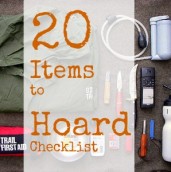20 Items to Hoard Checklist

When a crisis is brewing, making a comprehensive list of supplies is no easy task… neither is purchasing them.
As panic spreads, super market shelves will be stripped bare in a matter of hours. Contrary to popular belief, super markets don’t have tons of excess inventory. What you see on the shelves is what they’ve got in most cases.
We see it almost every time a major hurricane targets a populated area. Desperate shoppers buy up every last can of beans, flashlight, and bottled water in a 50-mile radius.
If you’re smart, you won’t be standing in line at the grocery store when the SHTF. You’ll already have that taken care of…
Because you’ve read through this checklist to make sure you have everything your family needs to survive a crisis. Here are our Top 20 Items to Hoard:
1. Rice – Dried rice has an incredibly long shelf life, making it ideal for storage. In nutritional terms, rice is rich in starch and carbohydrates. It’s also a good source of Vitamin B, iron, and protein.
2. Beans, Lentils, Black-eyed peas – Legumes are a great source of protein, iron, and dietary fiber. Like rice, which they’re traditionally served with, dried beans have an exceptionally long shelf life.
3. Candles – You’ll probably never read a disaster preparedness list that doesn’t include candles, and for good reason. A good stock of slow-burning emergency candles is a survival essential, as well as something to light them with.
4. Cigarette Lighters – I recommend stashing a combo pack of at least 6 lighters in your stockpile. In a power outage, these guys can become very, very important. The can also be very easy to misplace.
5. Pasta – Pasta stores well, has a long shelf life, and it’s loaded with carbohydrates. It’s also easy to prepare. Not to mention, pasta pairs well with lots of other items on this list.
6. Peanut Butter – Hoarded by everyone from college students to doomsday survivalists, and for many of the same reasons, peanut butter is a tasty, shelf stable source of protein that pairs with lots of other items.
7. Can Opener/Multi-Tool – It’s a good idea to carry a survival knife, but it’s a great idea to carry a quality multi-tool, like a Leatherman. A Leatherman comes in handy almost every day under normal circumstances and could be used as a weapon in a pinch.
8. Dried fruits, such as raisins, apricots, and papaya – Dried fruits are a great source of nutrients, calories, potassium, and fiber. They can also be added to nuts to make delicious trail mixes.
9. Energy bars – Since these bars are typically loaded with carbs and protein by design, they’re actually a good choice for your survival storage (maximum nutrition with minimal effort and prep).
10. Canned soups and chili – Canned soups are easy to prepare and offer a nice variety of ingredients for the effort. Look for low-sodium options. Premium brands may be healthier, but value brands will make your money go further.
11. Gauze/Bandages – For more serious injuries, you’ll want to keep a supply of dedicated gauze and bandages.
12. Rubbing Alcohol – Rubbing alcohol burns on an open wound, but it is a great way to sterilize instruments, surfaces, and the skin surrounding a wound.
13. Batteries – Obviously, you’ll need to coordinate your battery storage plan with any of the flashlights, radios, or other devices you may keep in your emergency stockpile. Batteries will last longest in cool dry conditions, but should be rotated out of your emergency supply on a yearly basis.
14. Toilet Paper – Running out of toilet paper is annoying in any situation. But you certainly don’t want to run out in a shelter-in-place crisis scenario. My advice is to get more than enough. Life can get messy.
15. Trash Bags – Trash will still need to be properly disposed of, even in a crisis. In fact, trash bags are even more important in a crisis. If running water is unavailable, trash bags may have to double as a toilet. Don’t skimp here.
16. Firearms – Last but certainly not least, you’re going to need some type of weapon, just in case. It doesn’t have to be a gun, but then again what else are you willing to risk your family’s safety on, a sword? Pepper spray?
17. Drinking Water – Most experts recommend a 2-week supply of water in your emergency storage. A 72-hour supply is the bare minimum. A water filter can help you extend you supply by allowing you to reuse cooking water.
18. Hand-Crank Radio – Hand crank radios offer the ability to listen to important communications when power and cell networks are down. Some hand crank radios even offer a USB charging functionality.
19. Camp Stove – There are a million options available for this purpose – everything from handy backpacking stoves to heavy-duty outdoor ranges – but it’s hard to beat the old self-contained Coleman camp stove.
20. Flashlights – When it comes to flashlights, I have two recommendations, and neither one is expensive. First, find a comfortable LED headlamp. Second, rather than finding the brightest, most high-tech available, invest in a Maglite that runs on simple AA batteries.

No comments:
Post a Comment